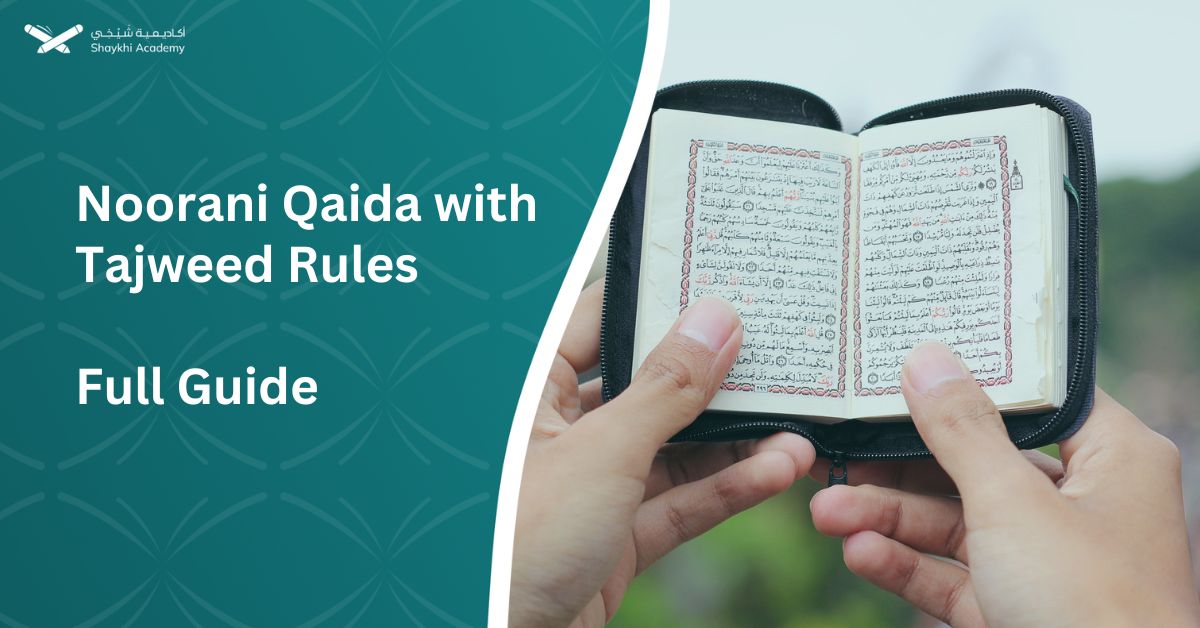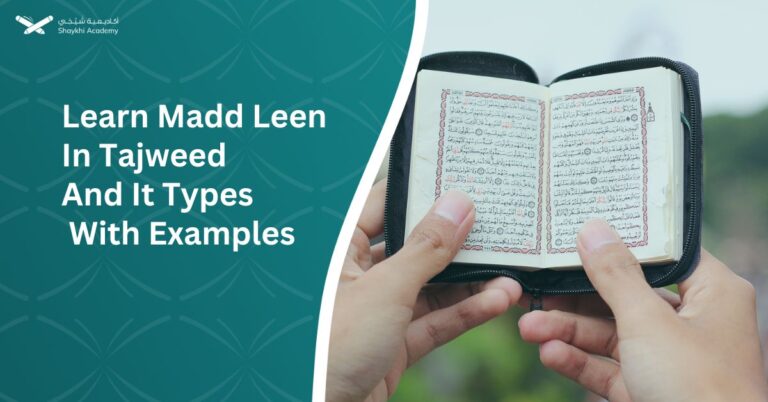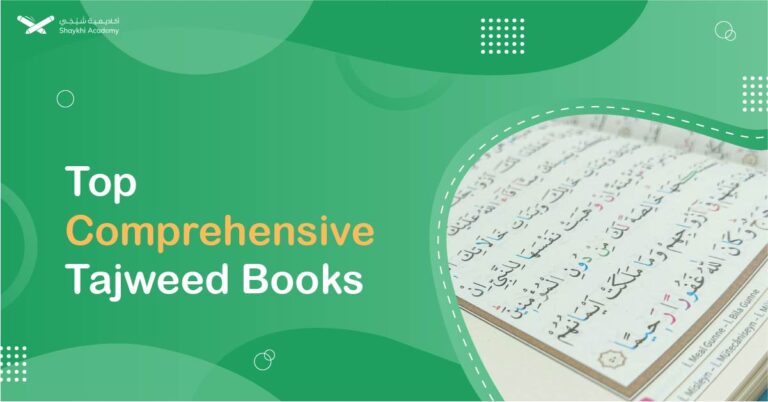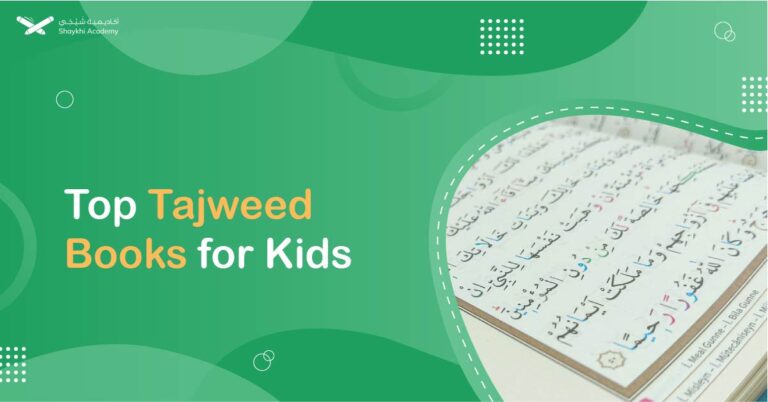Noorani Qaida with Tajweed rules is an essential method for beginners, particularly children, teaching Arabic basics and Quranic recitation fundamentals. Covering pronunciation, letter connection, and articulation, it ensures accurate Quranic recitation.
Key Tajweed rules like Ikhfa, Idgham, and Iqlab guarantee precise pronunciation, while Noorani Qaida’s structured lessons facilitate gradual learning from recognizing letters to forming words with proper pronunciation and diacritic marks.
What are the Noorani Qaida with Tajweed Rules?
The Noorani Qaida with Tajweed method is an essential tool for teaching beginners, especially children, the basics of the Arabic language and the fundamentals of Quranic recitation with Tajweed rules. This method covers the Arabic alphabet, compound letters, vowel and non-vowel letters, Mushaddad (doubled letters), short and long vowels, and provides comprehensive exercises to reinforce learning.
The Noorani Qaida approach focuses on correct pronunciation, proper connection of letters, and understanding the points of articulation and emphasis. By applying linguistic principles to Quranic verses, learners develop a strong foundation in both the Arabic language and Tajweed.
Key Tajweed Rules in Noorani Qaida:
Noorani Qaida Tajweed rules include Ikhfa (concealment), Idgham (merging), Iqlab (conversion), Idhar (clear pronunciation), rules for Noon and Meem Mushaddadah, Laam, and Meem Sakinah, and various forms of Madd (prolongation). These rules ensure correct pronunciation and recitation of the Quran.
| Tajweed Rule | Explanation |
| Ikhfa (Concealment) | Concealing the sound of Noon Sakinah or Tanween with light nasalization when followed by letters from the group: ص-ذ-ث-ك-ج-ش-ق-س-د-ط-ز-ف-ت-ض-ظ. Example: “صف ذا ثنا كم جاد شخص قد سما دم طيبا زد في تقى ضع ظالما”. |
| Idgham (Merging) | Merging a non-vowel letter with a following vowel letter, resulting in a single, prolonged sound. Idgham can be with Ghunnah (nasalization) for letters: ي-ن-م-و (e.g., “مَنْ يَعْمَل”) and without Ghunnah for letters: ر-ل. |
| Iqlab (Conversion) | Converting Noon Sakinah or Tanween into Meem when followed by a Baa, accompanied by nasalization. Example: “مِنْ بَعْد”. |
| Idhar (Clear Pronunciation) | Pronouncing Noon Sakinah or Tanween clearly without merging or nasalization when followed by throat letters: ء-هـ-ع-ح-غ-خ. Example: “همزة، فهاء ثم عين حاء مهملتان ثم غين خاء”. |
| Rules of Noon and Meem Mushaddadah | Pronouncing Noon and Meem with a clear nasal sound (Ghunnah) when they are doubled (mushaddadah). Example: “مَلِكِ النَّاسِ”. |
| Rules of Laam | – Laam Qamariyah (Clear Laam): Pronounced clearly when followed by letters: ا-ب-غ-ح-ج-ك-و-خ-ف-ع-ق-ي-م-ه. Example: “الحمد لله”. – Laam Shamsiyah (Merged Laam): Merged with the following letter if it is one of these: ط-ت-ص-ر-ث-ض-ذ-ن-د-س-ظ-ز-ش-ل. Example: “الظالمون”. – Laam in Verbs and Prepositions: Merged if followed by Laam or Raa (e.g., “قُل رَبُّكمْ”) and pronounced clearly otherwise (e.g., “قُلْ هُوَ اللهُ أَحَدٌ”). |
| Rules of Meem Sakinah | – Ikhfa Shafawi: Concealing Meem Sakinah when followed by Baa, with nasalization. Example: “ثم أنهم بعد ذلك”. – Idgham Shafawi: Merging Meem Sakinah with another Meem, producing a prolonged sound. Example: “لهم ما يشاءُون”. – Idhar Shafawi: Pronouncing Meem Sakinah clearly when followed by any letter except Baa and Meem. Example: “ألم نشرح”. |
| Madd (Prolongation) | – Madd Asli (Natural Prolongation): Lengthening the sound of letters by two counts when followed by non-hamzah and non-sukoon. Example: “الرحمن”. – Madd Far’i (Secondary Prolongation): Lengthening due to a following hamzah or sukoon, requiring different prolongation counts (4-6). Examples: – Madd Muttasil (Connected Prolongation): Followed by hamzah in the same word. Example: “جاء”. – Madd Munfasil (Separated Prolongation): Followed by hamzah in the next word. Example: “إِنَّا أَنْزَلْنَاهُ”. – Madd Laazim (Necessary Prolongation): Followed by a permanent sukoon, whether merged or not. Example: “الضالِّين”. |
Noorani Qaida Lessons:
The Noorani Qaida book consists of seventeen lessons, arranged sequentially to guide students from recognizing individual Arabic letters to forming words with proper pronunciation and diacritic marks. Below is an overview of the lessons included in the Noorani Qaida:
| Arabic Noorani Qaida Lessons | Content |
| Lesson 1 | Separate Arabic letters |
| Lesson 2 | Compound letters (Al-Huruf Al-Murakaba) |
| Lesson 3 | Abbreviated Letters (Al-Huruf Al-Muqatha’ah) |
| Lesson 4 | Vowel letters, short vowels (Al-Huruf Al-Mutahareka) |
| Lesson 5 | Nunated letters (Al-Huruf Al-Munawana) |
| Lesson 6 | Revision on vowel letters (Harakat) and Nunation (Tanween) |
| Lesson 7 | Small Alif, Yaa’, and Waw |
| Lesson 8 | Long vowels and incomplete vowels (Madd and Leen letters) |
| Lesson 9 | Revision on Nunation, long vowels, and incomplete vowels |
| Lesson 10 | Non-vowel letters (Al-Sukun) |
| Lesson 11 | Revision on non-vowel letters |
| Lesson 12 | Shaddah |
| Lesson 13 | Revision on Shaddah |
| Lesson 14 | Revision on Shaddah and Sukun |
| Lesson 15 | Revision on two Mushaddad letters in one word |
| Lesson 16 | Revision on Shaddah and Sukun with Madd (lengthening/elongation) |
| Lesson 17 | General Revision |
Benefits of Mastering Noorani Qaida with Tajweed Rules
Embracing Noorani Qaida with Tajweed rules brings numerous advantages for Muslims, enhancing the beauty and precision of Quranic recitation. Here are some of the key benefits:
1. Ensuring Accurate Meaning and Message:
By mastering Noorani Qaida with Tajweed, you ensure that each letter and word is pronounced accurately, safeguarding the Quran’s divine message. This meticulous approach prevents any alteration of the text’s intended meaning.
2. Strengthening Your Spiritual Bond:
Reciting the Quran with Noorani Qaida Tajweed rules mirrors the method of Prophet Muhammad (PBUH), transforming your recitation into an act of devotion. This deepens your spiritual connection with Allah, fostering a profound love and reverence for His words.
3. Enhancing Arabic Proficiency:
Noorani Qaida lays the foundation for perfect Arabic pronunciation, covering articulation points, sound qualities, and vowel lengths. This comprehensive understanding enriches your Arabic language skills, improving fluency and comprehension.
4. Boosting Focus and Mental Clarity:
The discipline required to learn and apply Tajweed rules through Noorani Qaida enhances your focus and concentration. These skills not only improve your recitation but also positively impact other aspects of your daily life.
5. Maximizing Spiritual Rewards:
In Islamic belief, the effort put into correctly reciting the Quran is greatly rewarded. Utilizing Noorani Qaida with Tajweed increases these rewards, offering spiritual benefits in both this life and the hereafter.
6. Inspiring Others by Example:
Reciting the Quran with impeccable Tajweed through Noorani Qaida sets a powerful example for others, especially the younger generation. It highlights the importance of preserving the Quran’s beauty and precision, encouraging others to strive for excellence in their own recitations.
Mastering Noorani Qaida with Tajweed rules is more than just an academic exercise; it’s a pathway to spiritual enrichment, linguistic mastery, and a deeper connection to the divine essence of the Quran.
Do I Have to Learn Noorani Qaida Tajweed Rules?
There is no single answer to this question as it depends on individual circumstances, skills, and levels of understanding. Here are some considerations to help you decide if learning Noorani Qaida Tajweed rules is essential for you:
1. Learning Noorani Qaida as a Communal Obligation:
Muslim students and seekers of knowledge, especially those in non-Islamic countries, have a communal obligation to learn Quranic sciences, including Noorani Qaida. This responsibility extends beyond personal learning to teaching others, helping preserve these important sciences in communities where Arabic is not commonly spoken.
2. Noorani Qaida for Imams Leading Prayers:
Imams who lead prayers must have correct recitation skills and a proper understanding of Noorani Qaida Tajweed rules. This ensures they do not misguide those praying behind them, maintaining accuracy in their spiritual leadership.
3. Parents’ Role in Learning Noorani Qaida:
Parents, particularly those raising children in non-Muslim countries, should learn the essential aspects of Noorani Qaida to correct their recitation and teach their children. While it may not be obligatory for all parents, those who are the primary source of Quranic education for their kids bear a significant responsibility. Shaykhi Academy offers Quran courses for women to help mothers achieve this goal.
4. Recommended Tajweed for Kids:
It is highly recommended for children to learn Noorani Qaida Tajweed rules during their formative years. Acquiring these skills early ensures accurate recitation and lays a strong foundation for a lifelong connection with the Quran.
Unlock the Path to Quranic Mastery with Shaykhi Academy!
Are you seeking the finest Quranic education right from the comfort of your home? Look no further! Shaykhi Academy stands out as a premier online Quran learning platform, dedicated to providing exemplary education to both children and adults.
Why Choose Shaykhi Academy?
- Connect with highly qualified native tutors.
- Flexible scheduling to suit your busy lifestyle.
- Affordable classes tailored for all levels.
- Accessible from anywhere around the globe.
Discover Our Range of Courses:
- Arabic Noorani Qaida: Lay a solid foundation for Quranic studies.
- Online Quran Classes for Kids: Engaging lessons for lifelong learning.
- Tajweed Rules for Kids: Learn to recite with confidence.
- Quran Hifz for Kids: Step-by-step guidance to memorize the Quran.
- Quran for Adults: Introduce yourself to Quran reading and Tajweed rules.
- Online Arabic Courses: Master the language of the Quran.
- Islamic Studies: A wide range of topics related to Islam, including theology, law, Quranic studies, Hadith.
Don’t Miss Out on Your Chance to Excel!
Whether you’re a beginner or seeking advanced knowledge, Shaykhi Academy can guide you! Book your free trial now and make Ramadan 2024 your Quranic turning point!
Conclusion
Noorani Qaida with Tajweed rules is a vital method for teaching beginners, especially children, the fundamentals of Arabic and Quranic recitation. It covers the Arabic alphabet, compound letters, vowel and non-vowel letters, Mushaddad, short and long vowels, and provides comprehensive exercises. The method focuses on correct pronunciation, connecting letters properly, and understanding articulation points by applying linguistic principles to Quranic verses.
Key Tajweed rules in Noorani Qaida include Ikhfa (concealment), Idgham (merging), Iqlab (conversion), Idhar (clear pronunciation), rules for Noon and Meem Mushaddadah, Laam, and Meem Sakinah, and various forms of Madd (prolongation). These rules ensure accurate recitation of the Quran, enhancing clarity, meaning, and spiritual connection, while also improving Arabic proficiency.




















